Transcribers Anonymous
Published in: 33. Transcription of Multitudes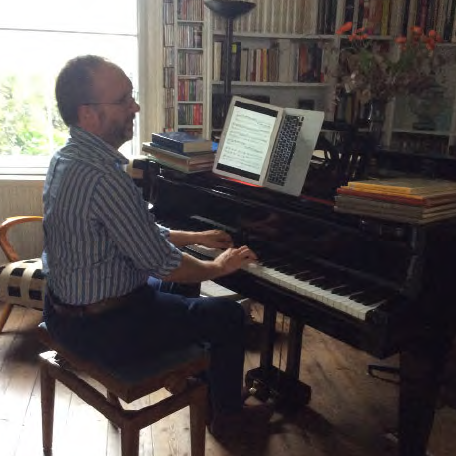
Tom Cobbe
About the Author: Tom Cobbe (aka Chaldean Urtext) is an editor of words who is now trying his hand at editing sheet music. Film, audio and gene editing may follow. He has been playing the piano since childhood and became interested in lesser-known Baroque classical keyboard music. He also likes finding rare reggae singles on YouTube.
It’s always the way.
When you’re trying out something for the first time, the pleasure of stretching your personal envelope, of encountering new challenges, puzzling them through and overcoming them, means you don’t realize you might be entering a danger zone where you become inordinately fascinated by things you’re almost ashamed to talk about in public.
My name is Tom, and I enjoy transcribing old keyboard music into modern notation so I and like-minded music obsessives can play it.
There, I’ve said it. The Transcribers Anonymous pledge. Don’t run away.
I’ve played classical piano since childhood and over the first COVID-19 lockdown got really interested in exploring the composers who are no longer household names but who wrote fantastic music. Once you’ve done your Bachs, Beethovens, Chopins, Handels, Mozarts, Schuberts and so on, it gets more fun to start exploring the fringes. I offer you Buxtehude, François Couperin and his uncle Louis, Frescobaldi, Froberger, Purcell, Scarlatti and Sweelinck, with a touch of Blow, Boyvin, Bull, Clérambault, Fux, Grigny, Hassler, Kerll, Krieger, Kuhnau, Martini, Mayone, Muffat (father and son from a Scottish family that who somehow ended up in Germany), Paradies, Rameau and Trabaci. And it’s worth checking out Pachelbel, who wrote so much more than just his famous canon.
Don’t get me wrong. There’s a reason why Mozart is so much better known than Martini, even though Wolfgang Amadeus respected the Padre very much. It’s like listening to classic albums or watching classic films. It’s easy to see why people think that Revolver or The Godfather should have a special place in your heart. But in the interests of diversity, equity and inclusion, maybe we should all ensure we also make room for Super Ape and Goke, Body Snatcher from Hell.
Twentieth-century avant-garde composer Edgard Varèse said, “The present-day composer refuses to die” (Frank Zappa’s favorite quote), but it seems that many of the more venerable composers were moldering slightly, forgotten, unloved and underappreciated.
During lockdown, I played a lot of piano. Maybe too much. And I especially valued the novelty of playing pieces I’d never heard before. It gave a sense of movement, even while everything else felt static, trapped under the ice. As published music is much more expensive than fiction or nonfiction because it is a niche product, I became an avid trawler of IMSLP.org. It’s a huge repository of out-of-copyright music, everything from medieval manuscripts through composers’ versions of their own pieces to 19th-century and early 20th-century printed scores to modern-day copyright-free editions created by users, all downloadable as pdfs.
Because I like early German keyboard music, I quickly discovered the series of books called Denkmäler deutscher Tonkunst (literally “Monuments of German sound art”). These are beautifully produced oversized tomes from the end of the 19th century and the dawn of the 20th. Monument by name, monumental by nature. German-published editions are quite often the main source for much music because so much was destroyed in WWII. And the Denkmäler editions are wonderfully clearly laid out, whereas some 19th-century editions have rather heavyset typefaces which make them hard to read. Think Victorian playbill posters. And editorial practice at the time was to splatter the page with all sorts of extra markings such as accents and crescendos. The fact that crescendos are impossible to achieve on a harpsichord, the keyboard instrument for which much of this music was written, didn’t seem to make much difference to these rather heavy-touch editors.
(As a quick aside, harpsichords have stops, like organs, so you can make the sound louder by changing stop or engaging another stop simultaneously, which makes the sound’s harmonics more complex – and richer is often interpreted by the brain as louder – but basically, however hard or fast you hit the key on an at any one time, the note’s volume is almost exactly the same. Players could only change sound in steps, rather than having a continuous transition from soft to loud and back. This is why 18th-century harpsichords and organs sometimes had more than one keyboard (manual) so that players could move more quickly between different sound colors. Double manual harpsichords were much rarer as they were so much more expensive.)
As I didn’t want to bankrupt myself by printing out downloads, I started playing from the screen of my wife’s rotated laptop computer, set to rest like an open book on the piano music stand.
So there I was, a user – a very active user – of IMSLP, but with inchoate dreams of making the quantum leap of self-transformation from consumer to contributor, from passive to active, so that others might derive similar satisfaction, too. Then I discovered a free music notation software program called MuseScore and thought that it was time to take the plunge into the Rubicon.
One of my paths of discovering music was looking at all of J.S. Bach’s pupils. As you can imagine, the internet is not short of resources on all things Bach, so it’s pretty easy to do. The interesting thing about his late career, in the mid-18th century, is that it was a transitional time for classical music. Bach himself represented the older Baroque tradition, which valued strict counterpoint (lines of music set against themselves in different configurations). Bach was considered out of date by the end of his career, with the fashionable rage being the “galant” style, which was more melody-driven, prioritizing surface brilliance over cerebral wranglings. This was the first beginnings of the classical period, which peaked with Haydn and Mozart, and lasted only about 50 years before Mozart and especially Beethoven started straining at the limits of classical respectability and order in the burgeoning Romantic revolution.
Concurrent with the galant style, there was another fascinating backwater, a strange 18th-century prefiguring of the Romantic music of Beethoven, Schubert, Schumann, etc, in what was called the empfindsamer stil. Meaning literally “sensitive style,” this was characterized by abrupt changes in mood – affect, in the terminology of the day – within a piece. It developed in Germany, and one of the chief protagonists was C.P.E. Bach, the oldest son of Johann Sebastian. Another driving force was his brother, W.F. Bach (check out his Polonaises and Fantasias).
Anyway, as a result of this, I got interested in the music of Bach’s pupil Johann Ludwig Krebs, considered the best pupil who didn’t have Bach as a surname. He wrote a lot of organ music, but like that of his teacher, it has a pedal part and I can’t do that (next year’s project?). So I thought I’d look at his works written for the keyboard. Most of this is intended for the harpsichord or clavichord, and then some of his later pieces could conceivably have been written for the fortepiano, the early piano.
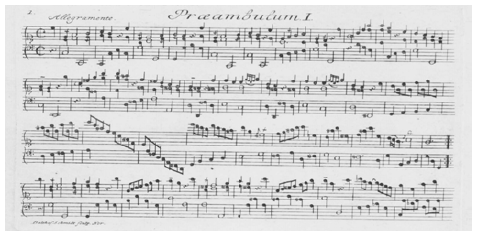
The first piece I transcribed – Krebs’s Præambulum in C major, Krebs-WV 813, from the Erste Piece, published in 1740 and notated in the soprano clef. Little did I know how passionate I would become.
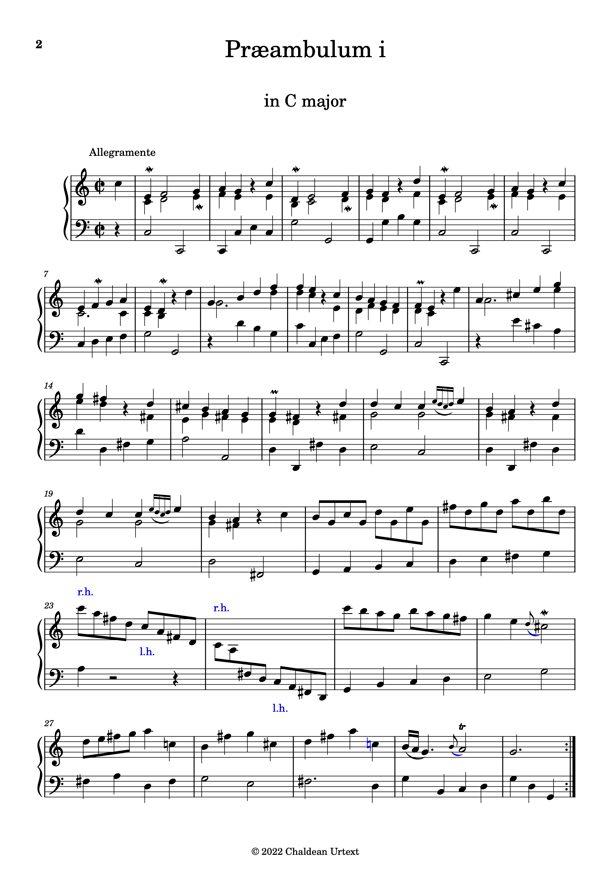
My treble clef transcription of it, published in 2022. Very little did I know about music theory and editing.
Krebs wrote some pieces in the Baroque style and some in the galant. And I discovered on IMSLP a set of preludes he published in 1740. These were fairly obviously written in homage (conceptually more than stylistically) to Bach’s Little Preludes for learners. When I tried to play them from the first edition, I immediately came up against a snag. The lower stave representing what should be played with the left hand is in the normal bass clef, but the upper stave is not in the usual G clef of all modern keyboard music but in what I discovered was the C (soprano) clef. This makes it hard to play if you’re not used to it, as the left hand is as you’d expect, but meanwhile you’ve got to instantly transpose (change the pitch) of what your right hand is doing. It’s as if half the keys on your computer keyboard changed and you had to touch type a dictation and try to simultaneously put your own spin on it, too.
I decided to transcribe these Krebs pieces into modern notation using MuseScore to make them playable for me and everyone else. In MuseScore, after entering the notes, you add ornaments (the musical twiddles that are vital to Baroque music) and slurs (the curvy lines on a page of music that tell you that you should treat that bit as a phrase) as you go along. With a bit of practice, the process becomes quite a lot quicker, but it still mops up a fair bit of time.
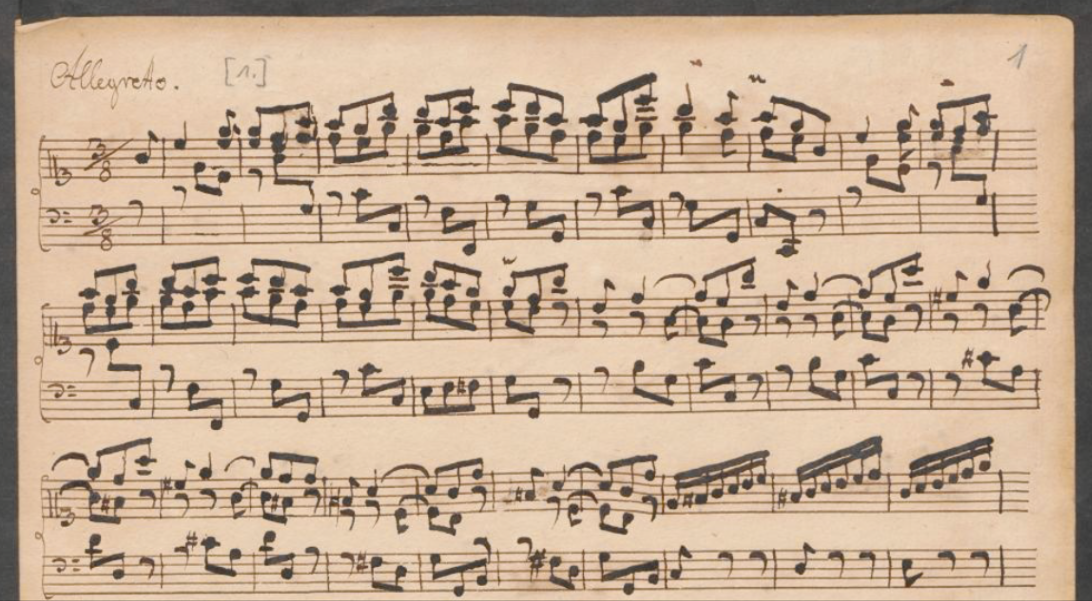
Detail of the opening page of Krebs’s Six Keyboard Sonatas, Krebs-WV 832–837, written by the composer in the soprano clef. Even though this is the first page, it’s actually the start of the third movement of the first sonata. This is because the manuscript is a convolute – basically, a combination of other individual manuscripts, so the running order for each sonata goes 3rd movement, 1st movement, 2nd movement. As I transcribed it in the manuscript order, I then had to paste all the music into another document, which lost all the little tweaks like upbeat bars (the fractional bit at the start of the piece). A hard lesson to learn.
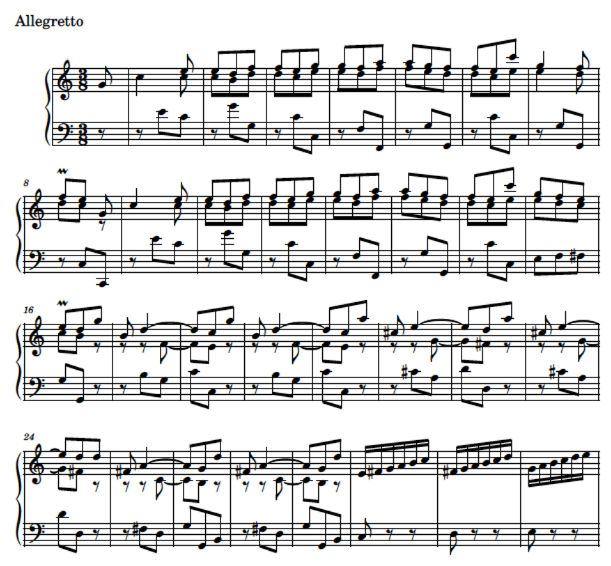
My transcription of this passage, published in 2022. As you can see, after much zooming and mulling and fretting, I decided that some of the markings on the manuscript were ink blotches rather than ornaments, after comparing it to a similar passage later on in the movement.
Once all the notes are inputted, then it’s time for the next and much lengthier phase: checking. This takes various forms. First, it’s very convenient that there’s a playback function, and that its speed is adjustable. It’s quite easy to spot if a note sounds “off,” and then you can hunt for that particular passage in the source (which can take a bit of time) and have another look. Then it’s good to check soprano-clef exported pdf against soprano-clef original – just looking at the shape of the notes on the page, rather than actually hearing the notes themselves. And then the final part is playing on the piano your own exported version by exporting the score as a pdf. Rather magically, you can instantly switch the right hand from being notated in soprano clef to normal clef, and all the notes jump to their normal positions. Once you’re sure that all the notes are right, there is an endless variety of tweaking available. I now have the thousand-micron stare of someone who has fiddled with the anchor points of slurs so they don’t collide with sharp or flat symbols or with the augmentation dots that lengthen a note’s duration because the algorithm has decided not to do you any favors this time around. I began appreciating pieces so much more now that I knew every note inside out, and some of them more than I wanted to.
Overall, these were reasonably straightforward pieces to do, even though it took lots of reminding myself of mostly forgotten music theory (it’s like having to go back and study the grammar of your own language), so I decided to go to the next level.
Again on IMSLP, I found Krebs’s French Ouverture, in which the composer was paying homage to the fact that Bach had written a wonderful French Ouverture for keyboard, itself paying homage to the French style of Baroque orchestral music, as exemplified by Rameau and Lully. Both Bach’s and Krebs’s pieces are examples of a suite — a selection of pieces in the same key, with individual movements often based on various national dances. And the slow Ouverture goes straight into a fugue (the kind of counterpoint mentioned earlier). This made it more complicated to input as I had to get the different “voices” to be distinguishable when you’re playing it. And indeed soundlessly studying it, if you’re a much better musician than I am. Fugues were designed for intellectual delight and not just pretty noise. Anyway, this is now on IMSLP too.
Now that I was truly hooked, things got even more serious. Having become a dab hand with soprano clefs and complicated voicing, I thought it would be a fun challenge to transcribe a musical manuscript, rather than “just” old printed music. And I found that in the Staatsbibliothek zu Berlin (Berlin State Library) there is a manuscript of six keyboard sonatas by Krebs. These pieces still aren’t very well-known because the manuscript was originally held in the Berliner Singakademie, and this whole archive was removed from the city by the Red Army at the end of World War II and wasn’t returned until 2001 from Ukraine. It includes a significant body of manuscripts by J.S. Bach’s sons.
Anyway, much note inputting later, and they’ve been published too. There has been a recent professional edition of these sonatas, which came out shortly after the archive was restituted, but of course that isn’t copyright-free. Mine is. Hope you enjoy it and get inspired.
And in a somewhat relentlessly inevitable evolution towards intricacy, elaboration and micro focus, now having successfully tackled simple pieces, fugues and manuscripts, I turned my hand to creating an even more complicated type of score – a comparative one. It is known that Krebs wrote at least six partitas (originally a name for a set of variations, but for Bach and Krebs it was another name for a suite, often longer and with more movements), of which three survive and only in manuscript form. Most music didn’t get printed but circulated in manuscripts among what CPE Bach called Kenner and Liebhaber – experts and amateurs. Both the Partita in E-flat major and the Partita in A minor have two different manuscript versions apiece. Both the later versions are by copyists close to Krebs; for example, the A-minor Partita was copied by Kirnberger, another composer who had studied under Bach and who is chiefly known these days for his collection of Bach chorale manuscripts (now known as the Kirnberger chorales) and for devising the Kirnberger temperament. In the modern professional editions of these two pieces, the editor chose to transcribe the later versions, saying somewhat disingenuously in the preface that the earlier versions (in Krebs’s own hand) had already been published. But the editions referred to are the kind of Victorian ones I mentioned earlier, and they contain some mistakes. So, rather romantically, I suppose, I wished to publish the edition that should have been published in the first place. There are multiple differences between the early and later versions of each piece, both on the large scale (whole movements being added or completely changed) and on the smaller scale of alternative versions of many bars. Having seen some editions that publish ossias (alternative versions of certain passages), I wanted to try to create one of my own. This transcription is proving rather time-consuming, but hopefully it will see the light of day in the near future.
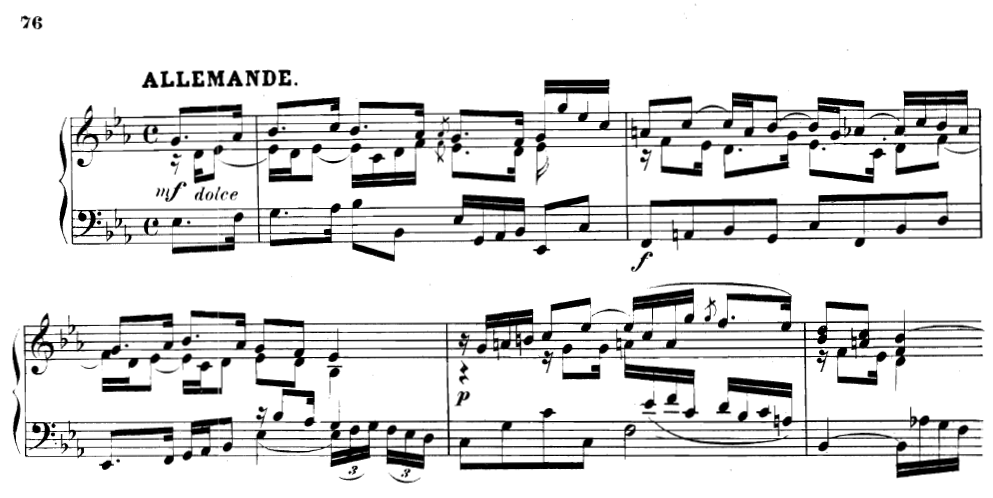
1. Opening of the Allemande from the Partita in E-flat major, Krebs-WV 827. This is an example of the kind of Victorian edition that is bespattered with inauthentic dynamic markings and instructions (the now-bitter addition of the word “dolce,” or sweet); it also has quite a few transcription errors. On other pages, some passages have wrong notes. Even though this page doesn’t have that, it does have various mistakes, which you can see from looking at the image of my comparison version or the image of the early version manuscript. First of all, the editor, Ernst Pauer, doesn’t follow the original title of “Allemanda,” but changes it to the more usual “Allemande.” It’s nice to follow the title as written (my joint edition will have a footnote about that, as the later edition has “Allemande”). Moving on to the music, the appoggiaturas (the little grace notes) in the first full measure have a strikethough line, which makes them acciaccaturas, which are played differently, as a crushed note rather than a leaning one. The last note in the left hand in the same measure is missing its ornament. In the next measure, the left hand is written as two groups of four notes, when it should be four groups of two. This is called the beaming of notes, and how they are beamed can be a deliberate decision of the composer to give guidance on choice of phrasing, so it’s better editorial practice to generally follow it or have a reason not to (e.g. the sharpness of the beam angles making it hard for composer to draw a common beam, or ornaments or other markings being in the way, etc). Two measures later, it’s missing the ornament on the third note on the right hand and the appoggiatura is again written as an acciaccatura. And in the final, incomplete measure, the left hand’s penultimate note is missing its ornament. But this Pauer edition, despite its faults, was very helpful in creating my own. For a start, it was the first printed edition of the piece I had seen, and gave me the desire to transcribe it in the first place. Interestingly, Pauer also transcribed the Partita in B-flat, but not the A minor one – both appear in the same excellently selected anthology, Alte Meister. Pauer’s edition of Krebs’s B-flat Partita was similarly useful as a starting point for my forthcoming edition. MuseScore’s import pdf function actually worked well for both (semi-beginner’s luck), which removed much of the donkey work of note inputting. And it is much easier comparing against a modern score than a manuscript, for the initial checking of the notes. Pauer’s versions also gave useful pointers about how to notate certain passages.
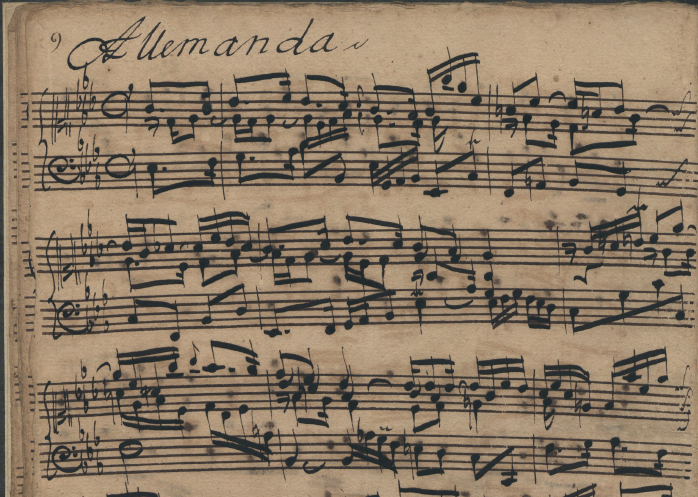
2. Opening of the same piece, in the first-version manuscript, in Krebs’s own hand (in soprano clef).
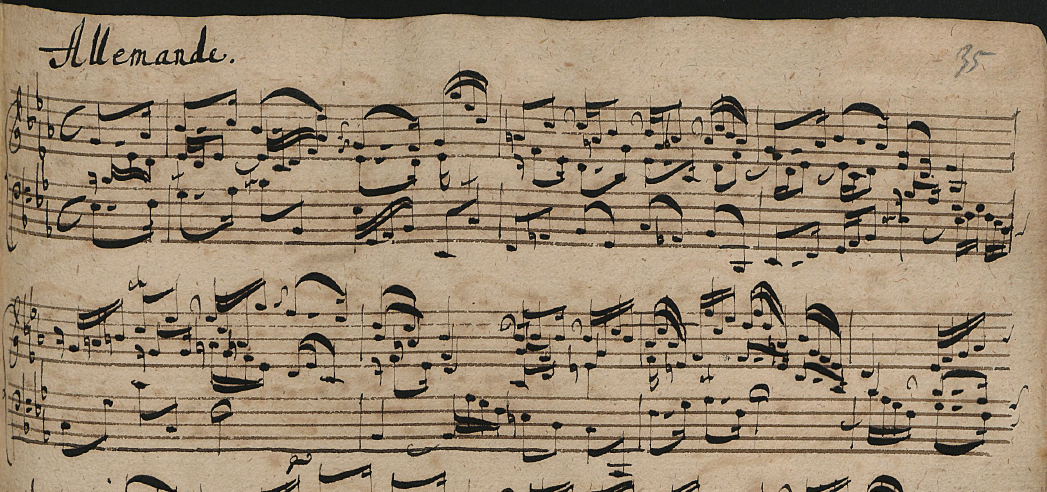
3. Opening of the same piece, in the later-version manuscript (in the treble clef).
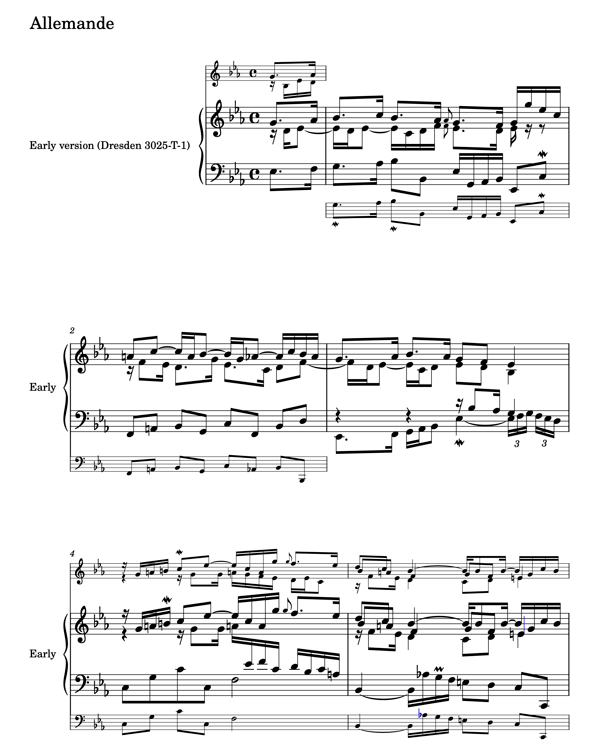
4. My comparison version – very much a work in progress. The early version runs along the two staves in the middle, and whenever a measure is different in the later version, it appears either above or below depending on which hand it applies to. There are probably multiple egregious errors nestling in there. But at least they’re different ones than from before, which moves the state of knowledge on a faltering step…
If you do decide to join the Transcribers Formerly Anonymous, you can search through RISM, a huge directory of both printed and manuscript music. This then links to the holding institution, and many of these scores are posted online. In fact, you can filter for the digitally available ones. RISM is quite handy for finding out your next project.
Some final thoughts. Permit me even more indulgence to reflect on the similarities between editing music and editing words, my day job.
At the core is creating a text that is easily understandable, which readers will then interpret according to their own sensibilities and life experience.
Like any subject, received wisdom and ideals change with time, and you can trace an evolutionary arc of this over time. And this becomes just as interesting as the texts themselves.
I’m still learning the finer (and probably rougher, too) details of good practice in musical editing, as I’m very much a newbie. But I’ve already realized that to make things clear takes a lot of background work, which, if appreciated at all, is usually at a subconscious level.
There are lots of little shorthands and rules. For example, in the Baroque time, if you had an accidental (raising or lowering a note a semitone from its normal pitch) attached to a note, then it held true if the same pitch occurred on the next note or the next but one, even if that one was in the following measure. Nowadays the accidental holds true for the remainder of the measure unless canceled. But then things get more complicated, because in 18th-century music if the pitch occurs, say, four notes later in the measure, it is normally considered no longer altered (nowadays there would be a canceling sign, and sometimes there is indeed one in 18th-century music). Sometimes composers omitted the confirmatory accidental later on in a measure, so you have to guess whether they intended that note to have reverted or not. It seems that 18th-century composers expected players of their music to fill in the musical gaps, to cognitively join the dots. Which is a rather long way of saying that notation requires musical interpretation, just as all written words require active reading.
I have been trying to create what is called an urtext edition (i.e. to get back as close as possible to the original text) and have highlighted changes by having any of these marked in blue. This was because many urtext editions use strikethroughs for slurs or put accidentals in brackets, but the strikethrough slurs were hard to do on MuseScore. And I find brackets and strikethroughs cluttering and distracting. But I then decided that it didn’t really help the player to know when I had inserted an accidental at the beginning of the bar because in the original text its effect was hanging over from the previous one. The rules have changed and so sometimes the best edits are the invisible ones; put differently, explanation comes at the cost of clarity.
And your relationship to the text changes as your understanding deepens. Same with any subject knowledge.
Even urtext scores require editorial judgment. But the difference from editing words is that the stated aim is to draw attention to the changes made. Imagine if books were published with the Track Changes version of Word drafts enabled: something deeply undesirable unless your sole desire is to engage in textual analysis.
The famous joke about writing about music is that it is as effective as dancing about architecture, so instead of my writing more, I invite you to explore the outer edges of classical (or any other kind of music) and look forward to you sharing that another time.
PS I’ve just discovered another manuscript, also in the Berlin State Library by Müthel, another Bach pupil with suites, sonatas and sets of variations. Oh dear. There go the holidays.
PPS It’s now getting even more serious than when I started thinking about writing this article. I want to head to Schloss Altenburg, where Krebs worked for decades. I’m going to see if I can play the organ he played on there, or at least go to a concert of his music performed on it. I’m also considering going on holiday to some European cities like Paris, Naples, Bologna and Venice, which have incredible libraries of music manuscripts, and consulting them in person. Don’t tell anyone.
Readers interested in further technical discussion or consultation about music transcription are welcome to reach out to me at chaldeanurtext@gmail.com.
Some links for you:
- My transcriptions:
https://imslp.org/wiki/Category:Urtext,_Chaldean
- Many libraries make a significant amount of their material freely available for all:
https://digital.staatsbibliothek-berlin.de/
https://digital.slub-dresden.de/en/digital-collections
https://explore.bl.uk/primo_library/libweb/action/search.do
https://collections.library.yale.edu/
https://gallica.bnf.fr/accueil/en/content/accueil-en
- The RISM link to Krebs’s French Ouverture:
It took me a while to realise that there was a copy of it sitting a few miles away from where I live, in the British Library. Once I did, I went along and consulted it. It’s a beautifully preserved book with the printing very sharp and crisp, but unfortunately it’s a special item, which meant I couldn’t take any pictures of it.
- The French Ouverture and the early version of Partita in E-flat major (along with another piece by Krebs), performed by Rebecca Pechefsky:
- The IMSLP page of Denkmäler deutscher Tonkunst and its successor series, Denkmäler der Tonkunst in Bayern:
https://imslp.org/wiki/Denkm%C3%A4ler_deutscher_Tonkunst
- Austria didn’t want to be left out of the Denkmäler party, so there’s some nice music here too:
https://imslp.org/wiki/Denkm%C3%A4ler_der_Tonkunst_in_%C3%96sterreich
- And this is how it was done before computer programs such as Sibelius and MuseScore. G. Henle Verlag editions are always beautiful and easy to read. Heartfelt thanks and love to Herr Kühner and his predecessors. Hope you all approve of what I’m getting up to.

Speak Your Mind